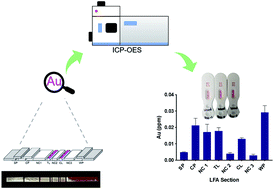Inductively coupled plasma optical emission spectroscopy as a tool for evaluating lateral flow assays†
Abstract
Lateral flow assays (LFAs) are immunochromatographic point-of-care devices that have greatly impacted disease diagnosis through their rapid, inexpensive, and easy-to-use form factor. While LFAs have been successful as field-deployable tools, they have a relatively poor limit of detection when compared to more complex methods. Moreover, most design and manufacturing optimization is achieved through time- and resource-intensive brute-force optimization. Despite increased interests in LFA manufacturing, more quantitative tools are needed to study current manufacturing protocols and therefore, optimize and streamline development of these devices further. In this work, we focus on a critical LFA component, colloidal gold conjugated to a detection antibody, one of the most commonly used reporter elements. This study utilizes inductively coupled plasma optical emission spectroscopy (ICP-OES) in conjunction with a lateral flow reader to quantitatively analyze colloidal gold distributions at the read-out test and control lines, as well as residual gold on the conjugate pad and other flow through regions. Our goals are to develop a more rigorous understanding of current LFA designs as well as a quantitative understanding of shortcomings of operational characteristics for future improvement. To our knowledge, this is the first time that ICP-OES has been used to study the initial distribution of colloidal gold on an unused LFA and its redistribution after a test is performed. Using three different brands of commercially available malaria LFAs, gold content was measured within each section of an LFA at varying parasite test concentrations. As expected, the total mass of gold remained unchanged after LFA use; however, the total mass of initial gold and its redistribution varied among manufacturers. Importantly, there are also some inherent inefficiencies that exist in these commercial LFA designs; for example, only 30% of the total gold deposited onto Brand A LFAs binds to the test and control lines, sections of the test that contain interpretable signal. Using information gathered with this method, future devices could be more purposefully engineered to focus on improved binding efficiency, resulting in reduced costs, improved limit of detection, and diminished test-to-test and manufacturer-to-manufacturer variability.



 Please wait while we load your content...
Please wait while we load your content...